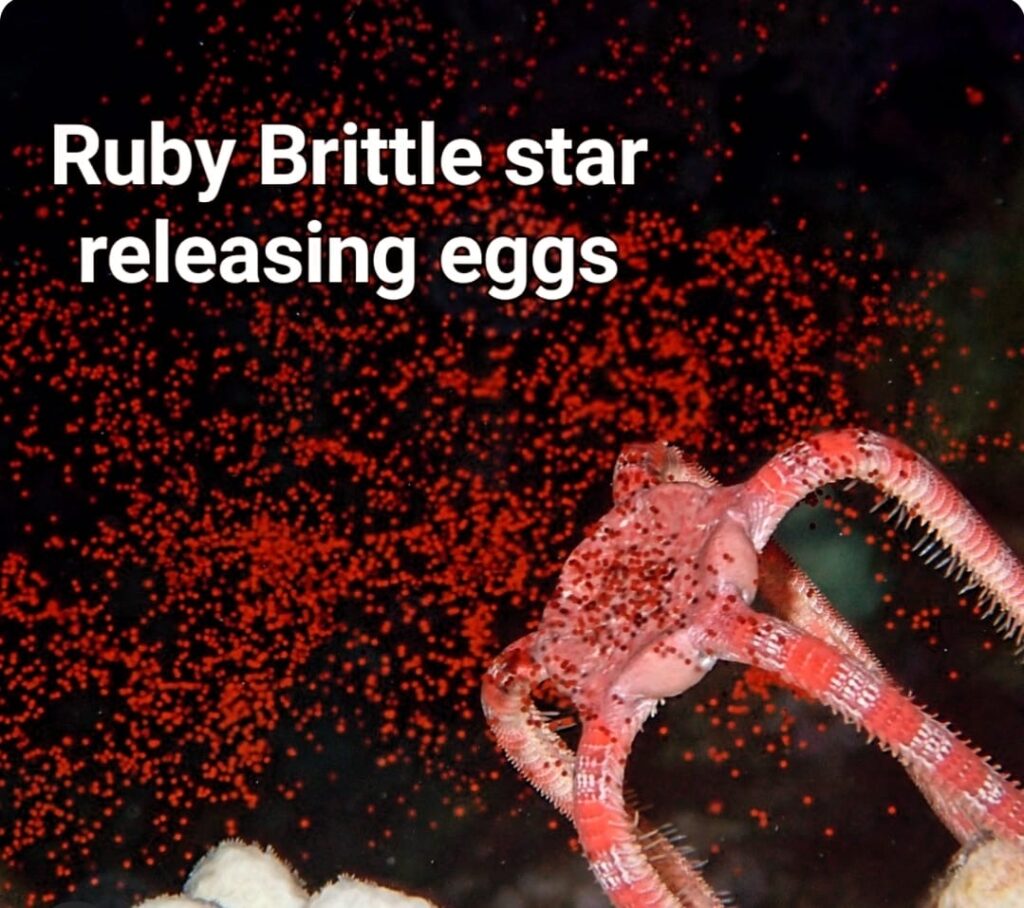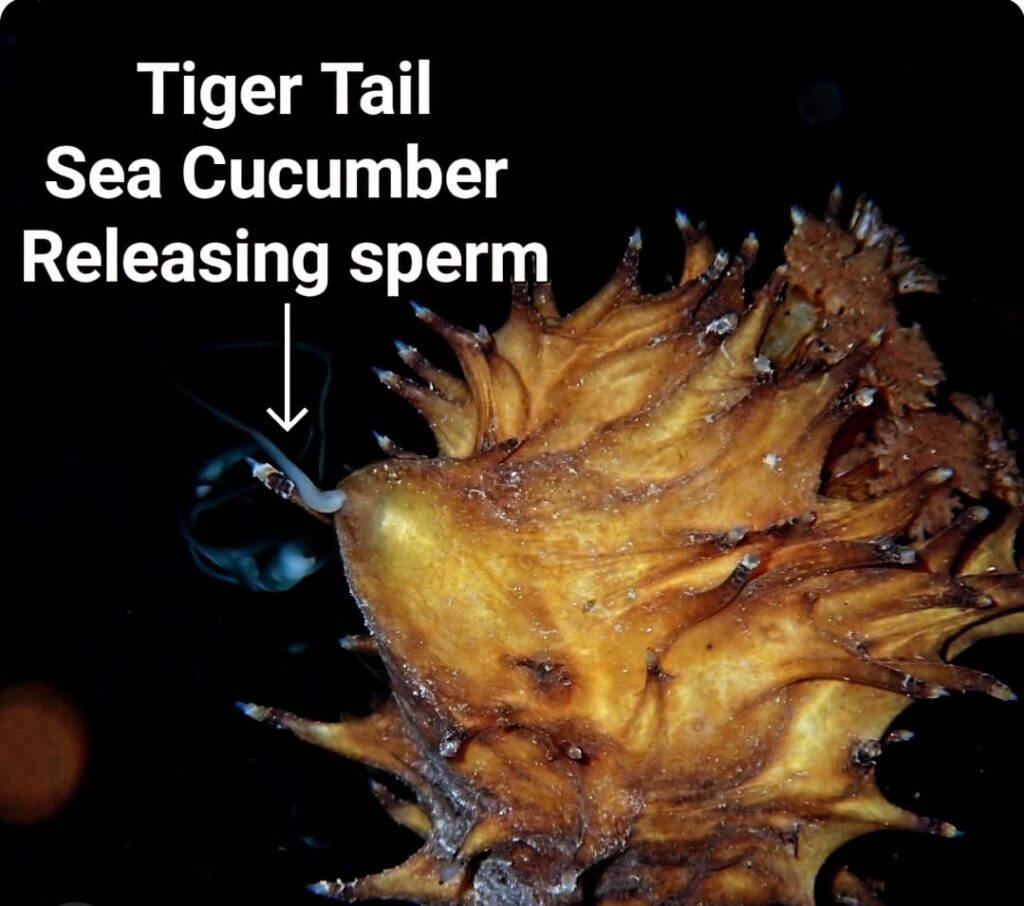
Our team of coral researchers, based at The Island School’s Cape Eleuthera Institute (CEI), just released their coral spawning predictions for 2024. They work in a collaborative project called The Bahamas Coral Innovation Hub with the Perry Institute for Marine Science (PIMS) and The Nature Conservancy (TNC) to develop, implement, and disseminate scalable coral restoration techniques to help counteract coral reef decline.
What is coral spawning?
Corals are sessile animals, which means that they are fixed in one place and can’t move to find mates, so they synchronize their spawning cycles with different environmental cues like water temperature, sunset time, and moon phases. Every summer, once the water temperature increases, several reef creatures know it is time to produce offspring by releasing their reproductive cells or gametes (females’ called eggs and males’ called sperm) into the water column. During mass spawning events, multiple colonies will all release their gametes at the same time.
Corals increase their size and regenerate after breaking by reproducing asexually, but they can also release their gametes to form new colonies and maintain their genetic diversity through sexual reproduction, which is what we call “coral spawning.”

Coral species produce eggs and sperm within the same colony and are known as Hermaphroditic broadcast spawners. Their gametes release in bundles that vary in size and color (from light pink to brown) depending on the species. Bundles released from the coral float up to the surface where waves break them apart, releasing the sperm and egg and allowing them to cross-fertilize with other colonies. Other coral species, known as Gonochoric broadcast spawners, have separate sexes; they release eggs and sperm independently with eggs that are similar to the gamete bundles, but much smaller. Sperm releases in bursts from the coral and looks like rising smoke. Once released from the colonies, the sperm and egg meet and combine in the water column.
Spawning events aren’t exclusive to corals; a number of other invertebrates such as sea cucumbers, brittle stars, and even sponges also undergo this process. Some invertebrates are more active during the night, like the ruby brittle star, which release eggs that appear as delicate red dots that balance on their outstretched arms. Meanwhile, the males emit a smoky cloud of sperm through tiny openings on their central disks.


How do we know when corals will spawn?
Researchers in the Caribbean have witnessed mass spawning events on the reefs and developed predictions for when different coral species will spawn. Beginning as early as April and going as late as October, the corals will use the change in water temperature as an indicator to spawn. The full moon triggers the process, followed by the setting of the sun.
The Bahamas is an archipelago of over 700 islands and cays spread out over 500 miles, with a variation in their longitudes. As part of creating our spawning predictions, we separated The Bahamas into three distinct zones according to sunset times. For specific islands it is recommended to follow exact sunset times.

Depending on the species and the days following the full moon and the sunset time, spawning could vary.
Take grooved brain coral, Diploria labyrinthiformis, for example. This coral spawns before sunset and has been found to release its gametes between 10 to 13 days after the full moon— usually all summer long starting in April. Other key building species and several invertebrates release their gametes during mass spawning events in the months of August and September between five to eight days after the full moon. Depending on the species, spawning could be seen at different times within the same night.
Relevant spawning information of key Caribbean species, months, and times are compiled in a booklet that contains field photographs and information on dates and times when spawning is expected to be observed. The booklet was created by researchers working at the Cape Eleuthera Institute (CEI) and the Perry Institute for Marine Science (PIMS) as part of The Bahamas Coral Innovation Hub (BCIH) project. Natalia Hurtado (CEI & PIMS), Silia Woodside (CEI), and Taylor Cargill (CEI) made the predictions as an educational tool to help local scientists, grassroots nonprofits, dive organizations, and volunteers work together to repopulate coral reefs across the region using larval propagation techniques.
Why is this information important?
The Bahamas relies heavily on its natural resources to attract tourists to its shores year after year, generating its main source of income. For these natural resources, The Bahamas has coral reefs to thank. Coral reefs provide benefits to the Bahamian livelihoods, such as providing sand for our beautiful beaches as well as providing a habitat to many economically important species like the Spiny lobster and Nassau grouper. However, coral reefs have steadily been in decline over the past few decades, mainly due to effects of climate change, such as rising sea temperatures and ocean acidification, as well as overfishing and a variety of coral diseases. Nowadays, many coral restoration efforts have sparked, with the hope of facilitating reef rehabilitation. In South Eleuthera, The BCIH team based at The Island School has been working with several coral restoration techniques, using their reproductive strategies to increase reef repopulation efforts.
Larval propagation is a coral restoration technique that takes advantage of the coral’s natural sexual reproduction by collecting their gametes and rearing them into juvenile corals in a lab setting. Using this method is highly beneficial as it increases the genetic diversity of the resulting coral offspring by cross fertilizing the gametes of different coral colonies.
Last year, we experienced an extreme heat wave and corals in The Bahamas are still recovering. As a result, a decrease in coral spawning is expected and predictions do not guarantee that spawning will occur. We are interested in conducting more spawning observations throughout The Bahamas to advance our knowledge and restoration techniques. Collecting gametes and rearing them until they are juvenile corals will increase their chances of survival. Once they are back on the reef, the juvenile specimens are more likely to produce healthy resilient coral reefs that can continue to provide ecosystem services for years to come.
For more information please contact nataliahurtado@islandschool.org.
Click below to see what is expected for the upcoming spawning season.